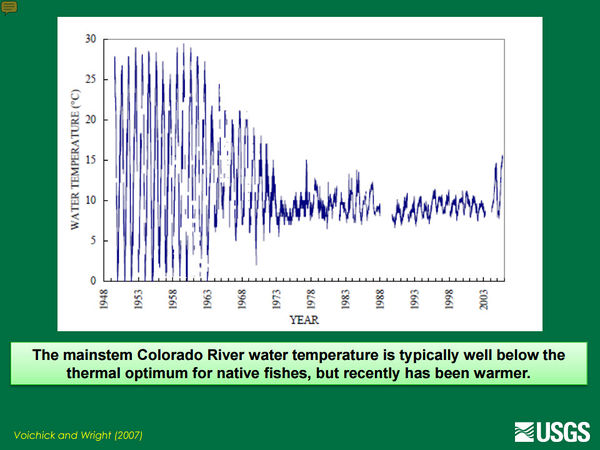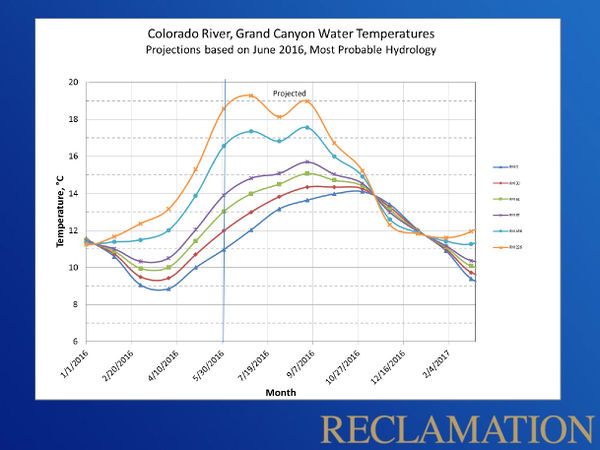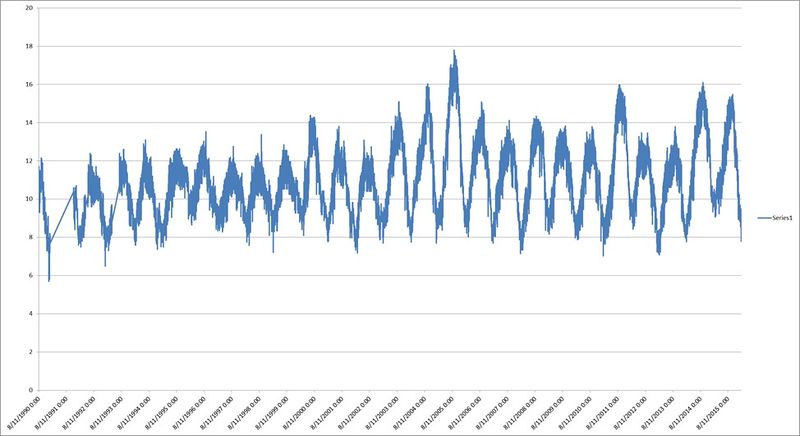Difference between revisions of "TEMPERATURE"
Cellsworth (Talk | contribs) |
Cellsworth (Talk | contribs) |
||
| Line 112: | Line 112: | ||
'''2013''' | '''2013''' | ||
| + | *[[Media:GCD-Temp Mod-Valdez & Speas 9-17-2013.pdf| Valdez et al. 2013. Benefits and risks of temperature modification at Glen Canyon Dam to aquatic resources of the Colorado River in Grand Canyon. U.S. Bureau of Reclamation, Upper Colorado Region, Salt Lake City, UT.]] | ||
*[http://pubs.usgs.gov/of/2013/1013/ Ross et al., 2013, Nearshore thermal gradients of the Colorado River near the Little Colorado River confluence, Grand Canyon National Park, Arizona, 2010: U.S. Geological Survey Open-File Report] | *[http://pubs.usgs.gov/of/2013/1013/ Ross et al., 2013, Nearshore thermal gradients of the Colorado River near the Little Colorado River confluence, Grand Canyon National Park, Arizona, 2010: U.S. Geological Survey Open-File Report] | ||
*[https://pubs.usgs.gov/fs/2013/3104/pdf/fs2013-3104.pdf Nearshore Temperature Findings for the Colorado River in Grand Canyon, Arizona—Possible Implications for Native Fish] | *[https://pubs.usgs.gov/fs/2013/3104/pdf/fs2013-3104.pdf Nearshore Temperature Findings for the Colorado River in Grand Canyon, Arizona—Possible Implications for Native Fish] | ||
| Line 134: | Line 135: | ||
*[https://www.usbr.gov/uc/rm/amp/twg/mtgs/09sep29/Attach_06.pdf Grand Canyon Monitoring and Research Center Updates] | *[https://www.usbr.gov/uc/rm/amp/twg/mtgs/09sep29/Attach_06.pdf Grand Canyon Monitoring and Research Center Updates] | ||
*[https://www.usbr.gov/uc/rm/amp/amwg/mtgs/09apr29/Attach_03a.pdf AIF: Grand Canyon Monitoring and Research Center (GCMRC) Update] | *[https://www.usbr.gov/uc/rm/amp/amwg/mtgs/09apr29/Attach_03a.pdf AIF: Grand Canyon Monitoring and Research Center (GCMRC) Update] | ||
| + | |||
| + | '''2008''' | ||
| + | *[https://www.usbr.gov/tsc/techreferences/hydraulics_lab/pubs/PAP/PAP-0972.pdf The Glen Canyon Dam temperature control device: restoring downstream habitat for endangered fish recovery] | ||
'''2007''' | '''2007''' | ||
| + | *[http://www.riversimulator.org/Resources/USBR/LTEP/ValdezTCDra2007.pdf Valdez and Speas. 2007. A Risk Assessment Model To Evaluate Risks and Benefits to Aquatic Resources From A Selective Withdrawal Structure On Glen Canyon Dam ] | ||
*[https://www.usbr.gov/uc/rm/amp/twg/mtgs/08apr08/Attach_05g.pdf Anderson and Wright. 2007. Development and application of a water temperature model for the Colorado River below Glen Canyon Dam, Arizona. Hydrological Science and Technology, V 23, No 1-4. ] | *[https://www.usbr.gov/uc/rm/amp/twg/mtgs/08apr08/Attach_05g.pdf Anderson and Wright. 2007. Development and application of a water temperature model for the Colorado River below Glen Canyon Dam, Arizona. Hydrological Science and Technology, V 23, No 1-4. ] | ||
| + | |||
| + | '''1999''' | ||
| + | *[http://www.nativefishlab.net/library/textpdf/11454.pdf Glen Canyon Dam Modifications to Control Downstream Temperatures, Plan and Draft Environmental Assessment] | ||
|- | |- | ||
Revision as of 11:20, 26 October 2018
|
|
Water Temperature below Glen Canyon DamPrior to completion of Glen Canyon Dam in 1963, the temperature of water flowing through the Grand Canyon each year was highly variable, ranging from the icy, spring run-off to the warm, 85-degree summer-heated flows. However, once the dam was constructed, the temperature of the water released from the dam - drawn from the depths of Lake Powell and released through the dam's penstock intakes - ranged for many years between 45 and 50 F (7 to 10 C). With the lowering of Lake Powell, release temperatures have been increased to as high as 59 F (15 C) which has likely led to an increase in the humpback chub and other native fish populations in Grand Canyon. These increases in temperature, however, also increase the risk of expanding the distribution and abundance of cool/warm-water nonnative fish like brown trout, green sunfish, smallmouth bass, and walleye which could have a devastating impact on the humpback chub population in Grand Canyon like they have on humpback chub and other native fish populations in the Upper Basin. |
| --- |
--- |
--- |
|---|



